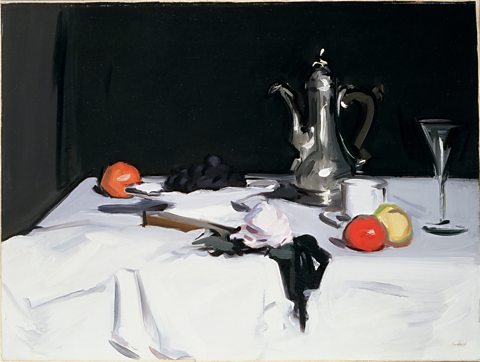Implied space
In two dimensional works, space can be implied using a range of techniques:
Size – larger shapes appear to be closer to us and smaller objects seem further away.
Colour – warm, vibrantBright, strong and full of energy. colours and darker tones seem to advance and appear closer to the viewer. Cooler, less vibrant colours and paler tints recede and feel further away.
Overlapping - a shape which covers part of another seems closer. A sense of depth is created as if one object was in front and the other behind.
Placement – objects that are higher in the frame look further away as if they were closer to a vanishing point.
Perspective – lines that grow closer together as they get closer to a vanishing pointThe point where parallel lines come together when they are shown in perspective. create a sense of depth and can make flat shapes seem like three dimensional forms with volume.
Atmospheric perspective – objects that are more detailed and that have clear outlines and edges seem closer. Those with less detail and that are less clearly defined appear further away.
Examples of implied space

In this Japanese woodblock print, space is implied through all these techniques.
Size - People in the foreground are larger than those in the background. The figures along the path get smaller as it stretches into the distance.
Colour – The orange of the buildings stands out and seems closer than the white of the fields. Areas of orange, pink, beige and grey are used in smaller amounts in the background compared to the foreground.
Overlapping - Buildings and people are overlapped. This creates a sense of depth.
Placement – The foreground is positioned lower down in the frame.
Perspective – The buildings are drawn with lines that lead to a vanishing point. They appear to get smaller as they head into the distance. The background seems flatter.
Atmospheric perspective – People and buildings in the foreground are detailed. Figures in the background are simpler outlines and blocks of colour.
These techniques are used in many types of art, not just landscapes. Still Life with Coffee Pot (Samuel John Peploe, c.1905) uses the same techniques to create a realistic sense of space and depth for a much smaller subject:

Size - The tangerine in the foreground is larger than the background fruit.
Colour – The tangerine in the foreground is a more intense orange.
Overlapping - The tangerine overlaps the peach which overlaps the coffee cup which in turn overlaps the coffee pot.
Placement – The tangerine, grapes and coffee pot are placed higher in the frame than the objects in the foreground.
Perspective – One point perspective is created by the line at the edge of the table.
Atmospheric perspective – The grapes in the background are shown with slightly less detail than the foreground fruit.
Question
What is the difference between real and implied space?
Real space refers to the physical area something occupies. Implied space means the illusion of space in an artwork.